Water
Mexico’s Floating Gardens Are an Ancient Wonder of Sustainable Farming
Standing amid rows of juicy, lime green lettuce and chunky florets of broccoli, Jose Paiz appears as if he could be the owner of a modern, high-tech farm. But the crops thriving here, in the suburbs of Mexico City, are part of a 1,000-year-old tradition.
“My ancestors were doing this before even the [Spanish] Conquistadors arrived in Mexico [in 1519],” says Paiz, while crouching down to pick up a handful of powdery soil from the chinampa, or “floating garden,” on which we are both standing.
These highly productive man-made island-farms, which can be found floating on lakes across the south of Mexico’s capital, date back to the time of the Aztecs or perhaps even earlier — and now proponents say that these ancient engineering wonders could provide an important, sustainable food source as the city faces historic drought.
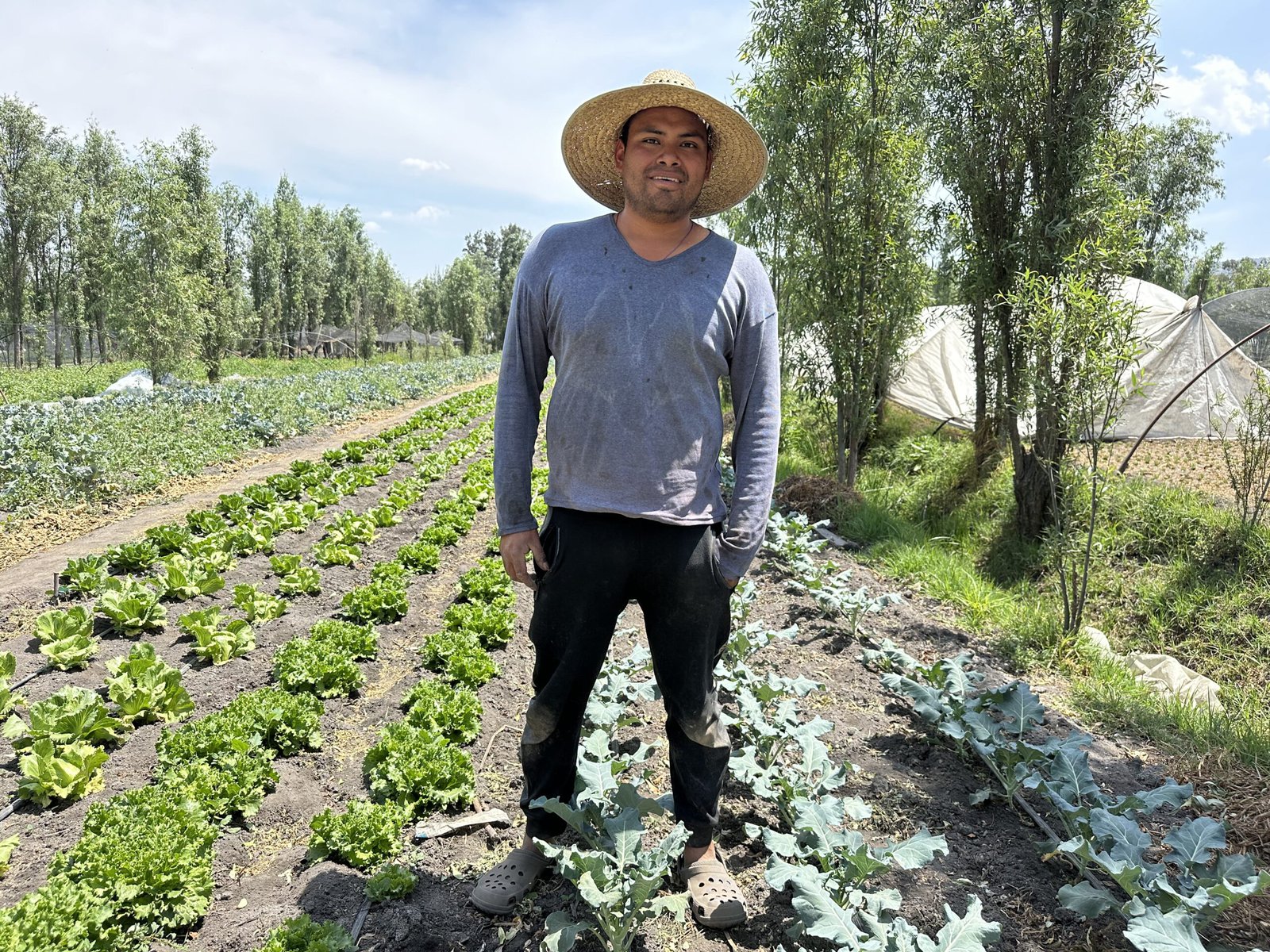 As a chinampero, Jose Paiz is carrying on a tradition that goes back centuries. Credit: Peter Yeung
As a chinampero, Jose Paiz is carrying on a tradition that goes back centuries. Credit: Peter Yeung
“My grandparents taught me the methods,” adds Paiz, 32, who is the fifth generation of his family to be a chinampero working in San Gregorio Atlapulco, a traditional working-class neighborhood about 10 miles south of the center of Mexico City.
Experts say that these chinampas, which have been recognized as a UNESCO World Heritage site, are considered one of the most productive agricultural systems in the world. The artificial islands are built by gathering large amounts of soil from the bottom of the lake and placing it on top of reeds, grasses and rushes in a mass that rises above the water. Farmers then plant a fence of ahuejotes, Mexican willow trees, around the plot to naturally protect against erosion. This system means that the chinampa’s soil is constantly enriched by nutrient-filled sediment flowing in from the surrounding ditches and canals, yielding multiple harvests every year.
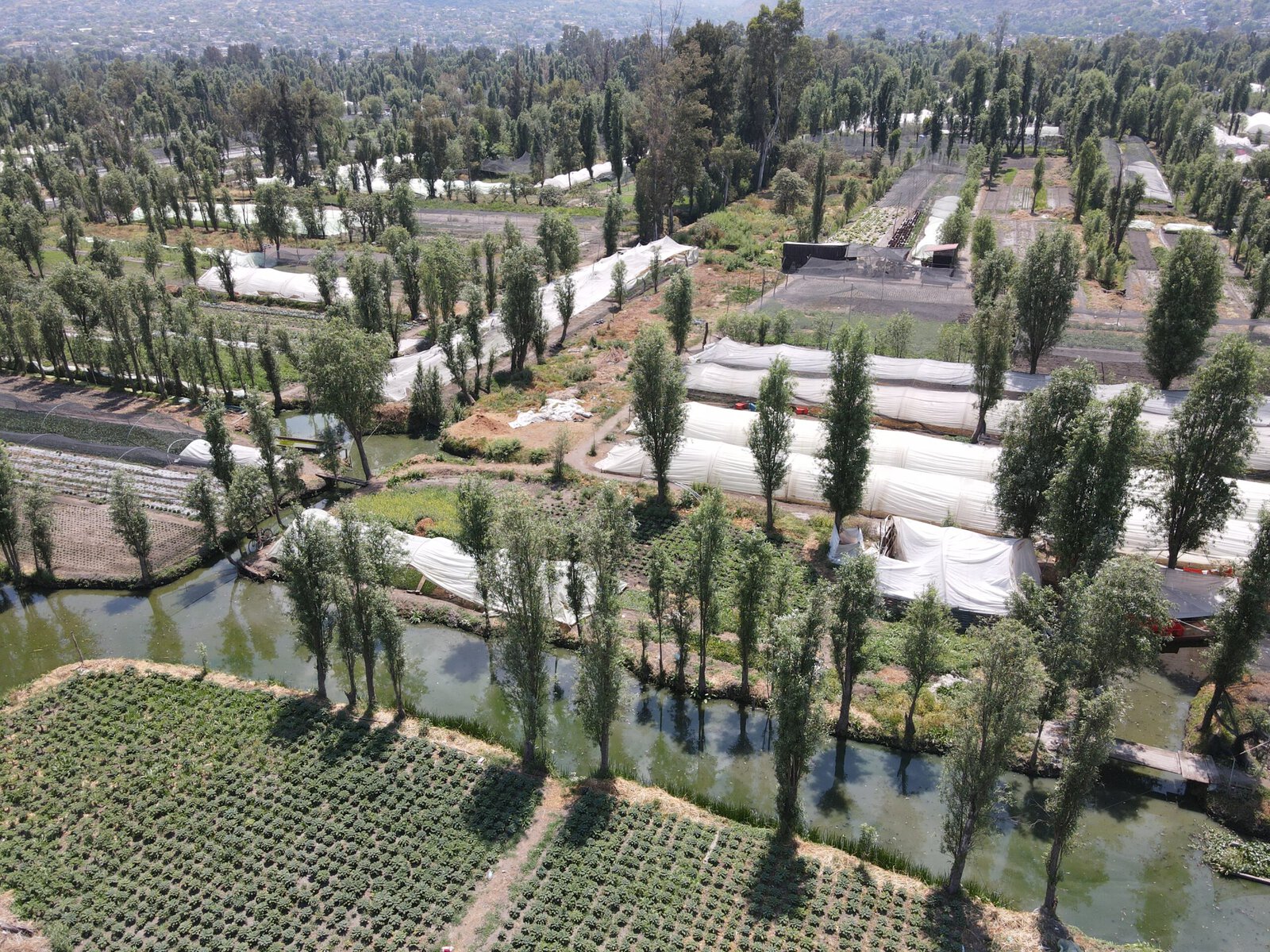 Ahuejotes, Mexican willow trees, are planted around the plots to protect against erosion. Credit: Peter Yeung
Ahuejotes, Mexican willow trees, are planted around the plots to protect against erosion. Credit: Peter Yeung
“In terms of agriculture, they are one of the best examples of how humans can work with nature,” says Lucio Usobiaga, founder of Arca Tierra, an organization providing local farmers in the area with technical and entrepreneurial support.
One of the first traces of the chinampas dates back to the 14th century, when the Aztecs arrived at the region of what is now modern-day Mexico City. There, they founded the settlement of Tenochtitlán — which would become one of the most powerful cities in all Mesoamerica — in the Valley of Mexico.
Crushed by negative news?
Sign up for the Reasons to be Cheerful newsletter.
[contact-form-7]
But as the Aztecs soon discovered, the valley’s boggy, lake-filled landscape was difficult to cultivate or build on. So they devised an ingenious plan to adapt to the surroundings: the chinampas.
A 2013 paper by North Carolina State University professor Matthew Teti found that in the 16th century, chinampa farms could produce 13 times as much crop as dry-land farming in the same area — a system that provided food for hundreds of thousands of people. Chinampas, the study said, are “one of the most intensive and productive agricultural systems ever devised.”
Credit: Peter Yeung
Greens and other vegetables flourish on the chinampas, which are considered one of the most productive agricultural systems in the world.
“Aztec planners created these vital waterways as integral to the existence of its cultural, physical, and spiritual, urban identity, rather than draining the water and excluding it from the urban experience,” it continued.
In the case of Jose Paiz, the age-old system is still reaping rewards today. He says that his 7,000 square meters of chinampa, for example, can produce as much as 100 kilograms of broccoli per day — which is sold alongside the yields of fresh herbs, spinach, chard, radishes, corn and kale at local markets in the south of Mexico City.
“I’m proud to be continuing the tradition of my ancestors,” he says.
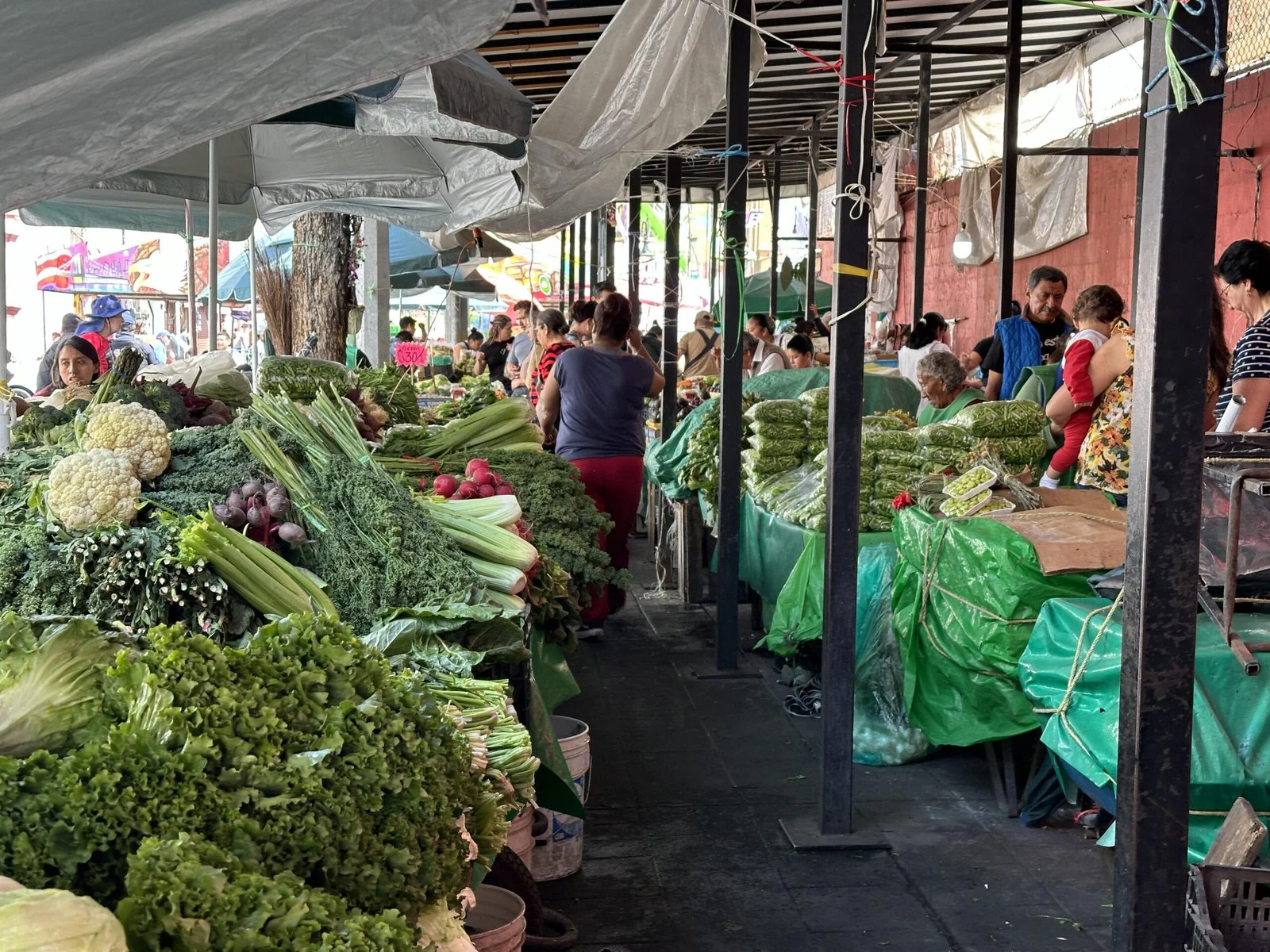 Produce grown on the chinampas is sold at bustling markets in the south of Mexico City. Credit: Peter Yeung
Produce grown on the chinampas is sold at bustling markets in the south of Mexico City. Credit: Peter Yeung
Meanwhile, according to Arca Tierra, their network of seven producers in the region cultivates over 40,000 square meters of land, employing a total of 27 workers in the field and producing 3,650 kilograms per month. At some farms, as many as 95 varieties of vegetables and herbs are cultivated, underlining the fertility of the method. The production brings in over $4,000 per month in crop sales.
“At the beginning, it was mainly a commercial endeavor to source organic produce close to the city,” says Usobiaga, who supplies restaurants in Mexico City and began working with chinamperos in 2009. “But I learned they are very important in many regards and have historical and cultural importance.”
The design of the chinampas is particularly efficient in its use of water, which it can absorb and retain from the surrounding canals for long periods as well as allowing crops to draw from the groundwater directly, reducing the need for active irrigation.
Credit: Peter Yeung
When it comes to farming, according to Lucio Usobiaga, founder of Arca Tierra, the chinampas “are one of the best examples of how humans can work with nature.”
This could prove hugely valuable for Mexico City and its 22 million residents, since water supplies have fallen to historic lows due to abnormally low rainfall partly attributable to climate change. And lessons learned from the chinampas could potentially help cities around the planet: the UN World Water Development 2024 Report found the number of people lacking access to drinking water in cities will likely reach two billion by 2050.
“The technical aspects of agriculture are innate to every place,” says Usobiaga. “But the way of thinking that created the chinampas, that sensibility, has to be appreciated and valued: To work with the flow of nature, the flow of the seasons. That is what we have to use to get us out of the problem we are in.”
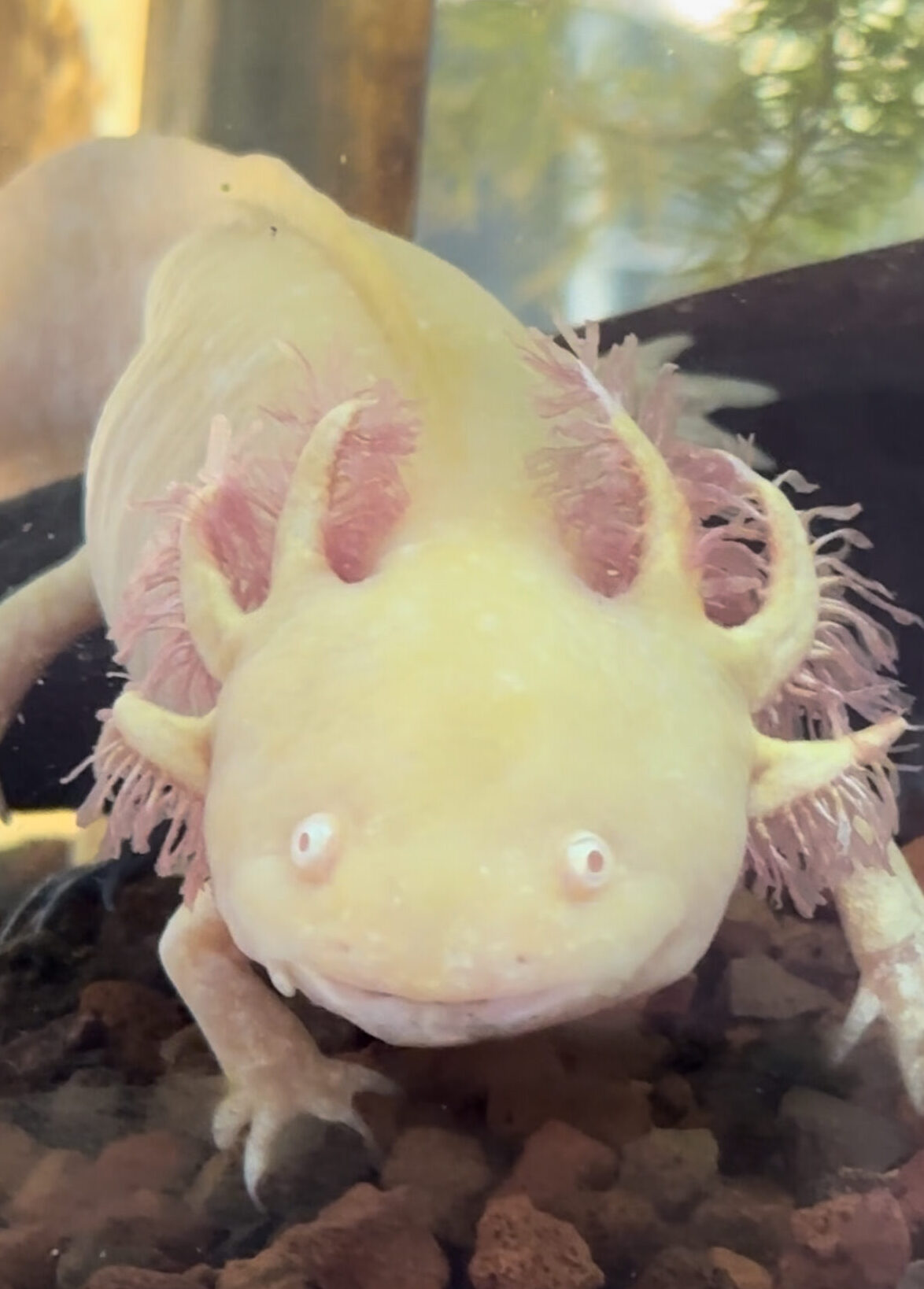 The endangered axolotl is only found in the waterways of southern Mexico City. Credit: Peter Yeung
The endangered axolotl is only found in the waterways of southern Mexico City. Credit: Peter Yeung
The unique wetlands ecosystem is also home to two percent of the world’s and 11 percent of Mexico’s biodiversity, including the critically endangered axolotl, or Ambystoma mexicanum, an incredible salamander-like amphibian that is able to regenerate every part of its body — even parts of its vital organs such the heart and brain.
Meanwhile, the chinampas also provide a host of other benefits: they filter water, cool the city, sequester carbon, offer green space for locals, and are now a popular destination for tourists who take boats along the picturesque waterways.
The value of the chinampas was underlined during the Covid-19 pandemic, when, as the city’s major markets ground to a halt, the chinampas were able to provide healthy, locally-grown food. In some cases, sales more than doubled.
“People began to search for healthier food,” says David Monachon, a social sciences researcher at the National Autonomous University of Mexico who has researched the chinampas as a sustainable food source. “There was this focus on local economy and community. Many people didn’t make this connection before.”
Yet despite their immense value, the chinampas are under threat: rising urbanization means the chinampa landscape is being built on; pollution is dirtying the waters that feed them; younger generations are losing interest in agriculture; and agro-industry is under-cutting the small-scale producers in a price war.
Credit: Peter Yeung
For chinamperos like Jose Paiz, the age-old agricultural system is still reaping rewards today.
“There are a lot of challenges and problems,” says Monachon, who is supporting a local cooperative of chinamperos to sell their goods via the Mercado Universitario Alternativo, or Alternative University Market. “But chinampas could feed the city.”
Now, only 20 percent of the 2,200 hectares of chinampas are in use, and only about 2.5 percent are being actively cultivated for farming food — the rest is being used for growing flowers and tourism. But Arca Tierra is helping to restore the chinampas — five hectares to date — and is training 15 young students in the required skills to cultivate them — the second, six-month cohort — while also carrying out research on the most effective techniques and productive crops to use on them.
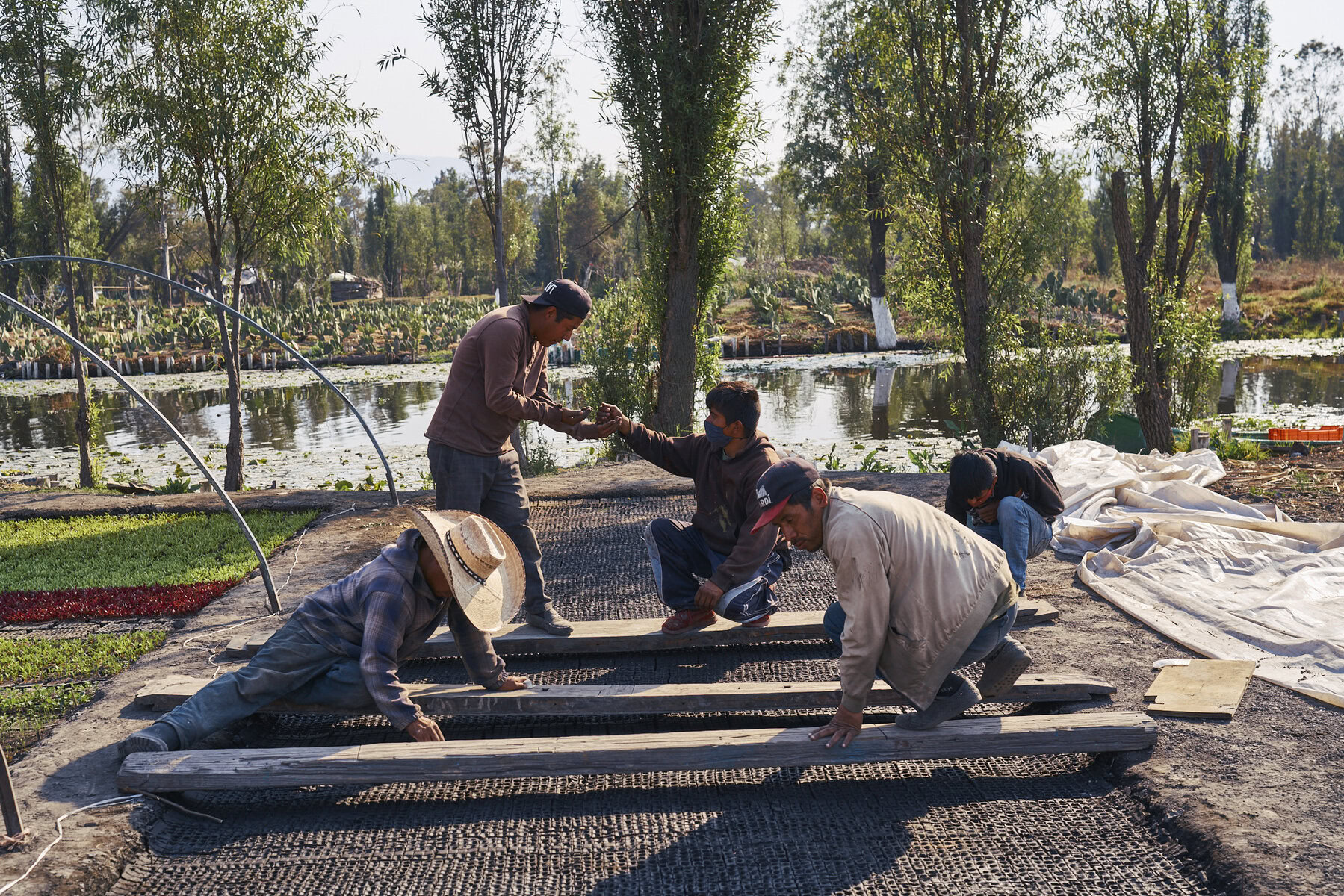 Arca Tierra is currently helping to restore the chinampas and training young students in the required skills to cultivate them. Credit: Antoli Studio / Arca Tierra
Arca Tierra is currently helping to restore the chinampas and training young students in the required skills to cultivate them. Credit: Antoli Studio / Arca Tierra
“We have demonstrated that it can be done on a small scale,” says Usobiaga, who believes chinampas have the potential to produce enough of crops like lettuces, herbs and broccoli for all of Mexico City. “But the chinampas need support and investment from the government to scale up production.”
At Xochimilco market, the largest in the area, there is clear evidence of appetite for a resilient, local food system and signs that this ancient Aztec tradition can still bear fruit. The market bustles with traders and customers, spilling from the covered area out onto the streets.
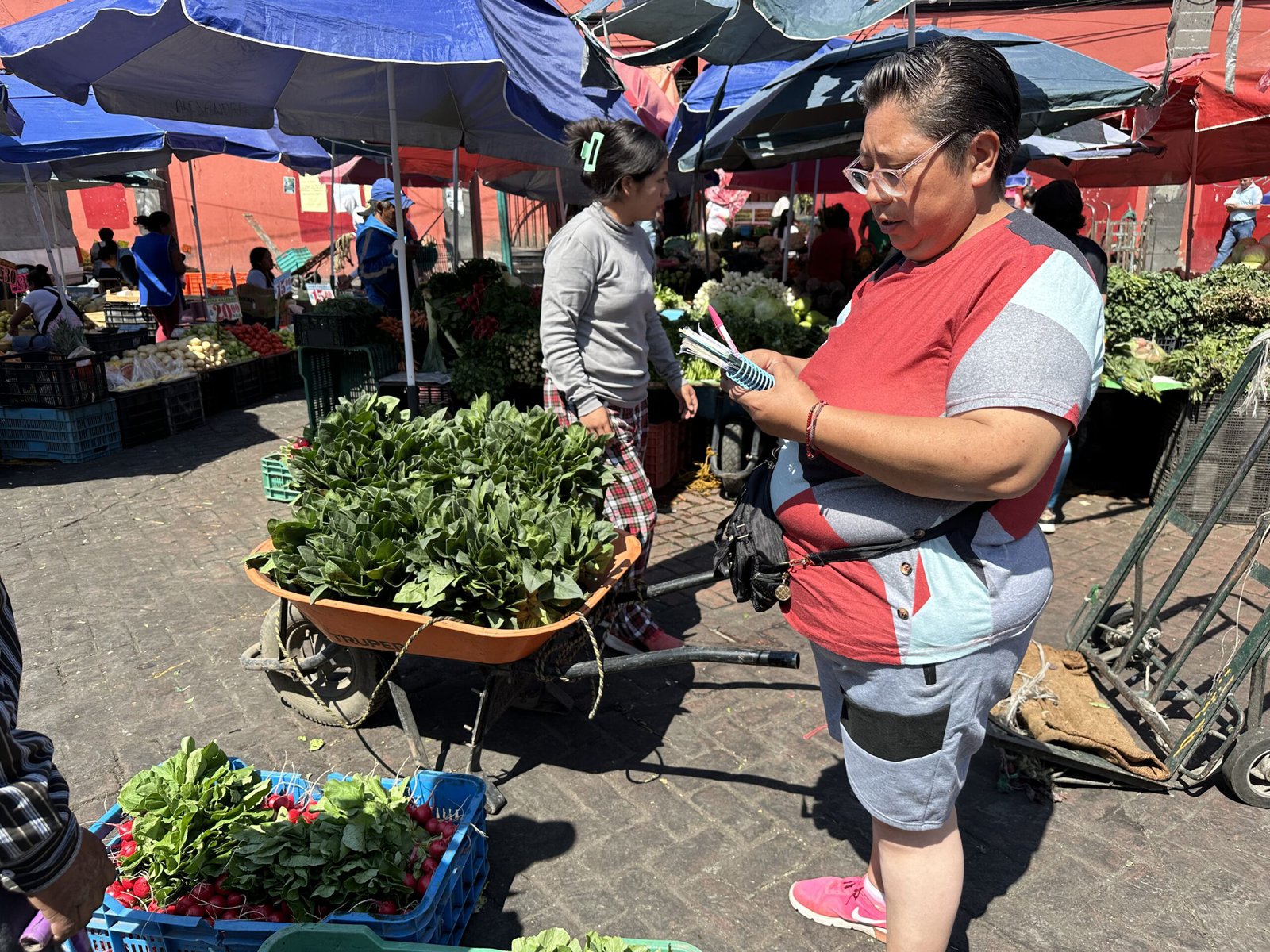 Rosa Garcia sells the produce that she grows on her family’s one-hectare chinampa at Xochimilco market. Credit: Peter Yeung
Rosa Garcia sells the produce that she grows on her family’s one-hectare chinampa at Xochimilco market. Credit: Peter Yeung
Rosa Garcia, 47, is rushing around delivering lettuce, spinach, cilantro and broccoli to her 14 clients of the day. The produce, grown at her one-hectare chinampa at San Gregorio Atlapulco, is in high demand. Garcia says that each day her family-run farm can earn as much as 1,000 to 1,500 Mexican pesos ($60 to $90).
“I’ve been doing this since I was a girl,” says Garcia, ticking off the orders as they are dispatched. “It’s a system that works. Why do anything different?”
The post Mexico’s Floating Gardens Are an Ancient Wonder of Sustainable Farming appeared first on Reasons to be Cheerful.
Water Theft in the Heartland: The Case of Tippecanoe County
by Dave Rollo
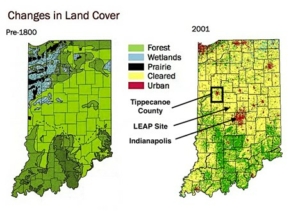
Indiana’s wetlands and rivers were appropriated for ag use, leaving cities dependent on groundwater. Green shading in left figure indicates different forest types. (Indiana University Department of Earth and Atmospheric Sciences).
Imagine a landscape with some of the richest wildlife habitats in North America. Settlements are scarce and water is plentiful. Birds dot the skies, mammals abound on the ground, and fishes fill the rivers and lakes.
That’s Tippecanoe County, Indiana. In 1800.
The county’s transformation over the past two centuries would make it unrecognizable to its original inhabitants. Today, much of Tippecanoe consists of flat plains of fertile soils. They host vast expanses of farmland, spotted with a few hills and valleys. The county’s makeover is emblematic of the change in much of northern Indiana.
The region’s extensive conversion to farmland brought changes that reverberate across the landscape today. A great example is the draining of the great midwestern marsh of northern Indiana—the Kankakee Grand Marsh, once comparable to the Everglades in size and biodiversity. Its elimination in the late 19th century caused half a million acres of wetlands to vanish, including the largest natural lake in Indiana. The loss rendered the landscape nearly devoid of surface water. It forced settlements to turn to the remaining rivers or groundwater to meet urban needs and to irrigate farmland. This conversion of wetlands to farmland contributed to water scarcity in Indiana and set the stage for battles over water resources today.
Growing Demand
Tippecanoe County, like most of west-central Indiana, is increasingly reliant on groundwater. The Teays Aquifer, which extends beneath ten counties in the region, is now the essential water source for Tippecanoe, together with the Wabash River, which is overused.

The Wabash River in Northern Indiana. (Chris Light, Wikimedia).
One of those ten counties is Marion County where Indianapolis dominates municipal governance. Given its projected water needs, the county may find the available water supply to be too confining. Dependent on the White River and the county’s own aquifer, city leaders and developers have long coveted surrounding water resources for the city’s expansion. In 2006 the city attempted to tap Monroe Lake, a reservoir some 60 miles to the south. That project failed after considerable resistance from multiple jurisdictions and state officials, including the governor.
The target of the growth boosters of Greater Indianapolis is the Teays Aquifer. They propose to transport water 50 miles to advance the largest development project in the state’s history. Developers call it LEAP, the Limitless Exploration/Advanced Pace Research and Innovation District. LEAP is a megasite—a type of enormous industrial and manufacturing center developed as a group effort by state agencies, universities, and private developers.
Unlike a failed attempt in 2006, LEAP has the support of the current governor. But whether appropriation of the water for distant growth ambitions comes to pass remains to be seen. The battle is just beginning.
The Wabash Consumed
We often think of water wars as occurring in the western USA. But conditions are shaping up for similar skirmishes in the Midwest. As recently as the fall of 2023, drought impacted some 50 percent of the Midwest. And periodic severe droughts have tested regional water providers. Furthermore, climate modelers predict that Indiana will have wetter springs but drier falls, with higher temperatures creating stress on humans and crops alike.
Already, seasonal droughts in Tippecanoe County have impacted the largest surface water source in the region, the Wabash River. Its watershed encompasses two-thirds of Indiana, and cities in the catchment area draw heavily from the river. During the summer, cities withdraw river water at nearly the same rate they replenish it. (Replenished supply is water used by power and sewage plants that is treated and returned to the river.) In other words, during its period of lowest flow, municipal users appropriate nearly the entire supply of river water. What will happen as demand for water grows?
The county also gets water from the Teays Aquifer. The twin cities of Lafayette and West Lafayette depend entirely on the aquifer to meet residents’ needs.
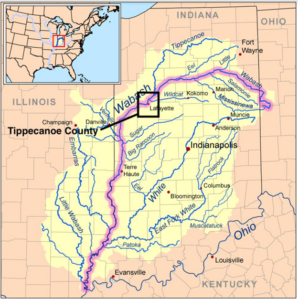
The Wabash River watershed serves much of Indiana and a significant portion of Illinois. (Wikimedia)
Tippecanoe County may have a secure water supply for the time being. But counties to the east and close to Indianapolis are not as fortunate. Boone County has rich agricultural farmland, but little subsurface water due to its underlying geology. So it has little potential to increase extraction. Yet the economic development community in Indianapolis has targeted Boone County—25 miles northwest of the city—for the enormous LEAP megasite.
LEAP is an industrial park facility with centers for pharmaceutical development, silicon chip manufacturing, and data storage. It is under construction on 10,000 acres of some of the best farmland in the state. It’s situated along Interstate 65, a superhighway connecting Indianapolis and Chicago.
Analysts estimate LEAP water needs at up to 100 million gallons per day. Yet Marion County (Indianapolis) and the counties surrounding it have no spare water capacity. For this reason, project developers propose to run a pipeline more than 50 miles to extract water from the Teays Aquifer in Tippecanoe County. This $2 billion pipeline plan has alarmed the public and brought scrutiny to LEAP. Yet many aspects of the project remain obscure.
Growth Boosters Shift Costs to the Public
The Indiana Economic Development Corporation (IEDC), whose board is appointed by the governor is a major cheerleader of LEAP. The IEDC and its associated foundation is a public/private partnership that is opaque to public scrutiny. Yet is Indiana taxpayer fund it to the tune of billions of dollars.
The IEDC keeps secret the names of private donors who provide supplementary funding, as donors request anonymity. But the public lobbying group Common Cause has noted that a thank-you to sponsors on the IEDC website mentions the five largest investor-owned utility companies in the state. IEDC has also been evasive regarding LEAP. It refuses to share internal reports, excluding the public from meetings, and failing to answer questions posed by citizens, citizen advocacy groups, and the media.
A December 2023 report from the largest citizen/consumer advocacy group in the state, the Citizen Action Coalition (CAC), found “significant and valid concerns” regarding LEAP. It also found that the project “will likely lead to an environmental and financial crisis for Hoosier taxpayers and utility customers.” The report notes that LEAP’s projected water extractions from Tippecanoe County may exceed the water use of 1.3 million average Indiana residents.

A sliver of the LEAP vision. (IEDC)
Tippecanoe County, with a population of 186,000, currently uses 35 million gallons/day from the aquifer—about a third of LEAP’s potential impact. Furthermore, the $2 billion cost of the pipeline and expansion of related utilities is as yet uncertain. (How often do we find massive infrastructure projects come in under cost?) The CAC warns that the cost of adding such capacity may well be borne by customers.
The CAC further revealed that the IEDC purchased the 10,000 acres and committed to greenlighting the site prior to securing the water needed or even conducting a water study of the project. It purchased some farmland at up to six times the assessed value. One farmer reported being approached by IEDC attorneys who “refused to disclose who they worked for or the reason behind the land purchase.”
After issuing their report, the CAC (along with major media outlets and local government officials) has requested answers to numerous questions raised by the LEAP project. Yet the IEDC has refused to meet or even respond. This led WTHR in Indianapolis to report last December that “Over the past eight months, the IEDC has refused all of our interview requests to discuss the project.” The IEDC even ignores inquiries posed by Tippecanoe County elected officials, whose municipal water may be affected by the pipeline. “The project has been shrouded in secrecy and lack of responsiveness since its initiation. Only public pressure has resulted in any willingness to discuss, in a very limited fashion and mostly through press releases, the potential for large-scale water diversion,” David Sanders, a West Lafayette city council member, told me in an interview.
Pushback from Tippecanoe County
Citizens and public officials are pushing back on the LEAP pipeline in Tippecanoe County. Both Lafayette and West Lafayette have passed resolutions against tapping their aquifer. Tippecanoe County has passed a moratorium on high volume withdrawals for the next nine months.
Stop the Water Steal, a citizen group founded by Councilmember Sanders, has rallied residents in Tippecanoe County to resist the pipeline and work toward an independent water analysis that will evaluate the effect of a potential 100 million-gallon-per-day extraction from the Teays Aquifer. This evaluation has been supported by legislators at the Indiana Statehouse.
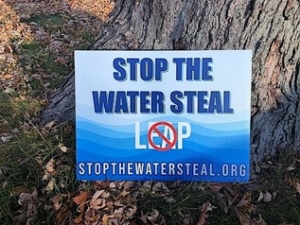
Tippecanoe citizens are pushing back against the pipeline that threatens their water supply. (Stop The Water Steal).
Richard Meilan, Professor of Natural Resources at Purdue University in W. Lafayette, found that test wells for the project created a drawdown of 1.5 feet after only a 2-million-gallon withdrawal over a 72-hour period. He lives only a mile from the test wells and spoke directly to a drilling company employee who expressed surprise at the decline of the water table. Dr. Meilan, CAC, and Stop the Water Steal have all remonstrated in public forums. Their efforts have garnered seventeen resolutions against the pipeline from county and city jurisdictions as far away as Bloomington, some 100 miles distant. “Don’t take the LEAP” might summarize their message.
Such resistance has prompted Indiana Governor Holcomb to pause the LEAP proposal pending further analysis of the pipeline’s impact by the Indiana Finance Authority (IFA). However, CAC Director Kerwin Olsen says this should not be considered a fully independent study. The IFA is under the authority of the governor, who is also Director of the IEDC Board. The delay, according to Olsen, is a political response to lower the project’s profile during an election season.
Fortunately, the delay also provides additional time for citizens and their representatives to continue to spread the word, gather evidence, and build resistance to the water theft in the heartland.
Dave Rollo is a Policy Specialist and team leader of the Keep Our Counties Great campaign at CASSE.

The post Water Theft in the Heartland: The Case of Tippecanoe County appeared first on Center for the Advancement of the Steady State Economy.
A Tidal Wetland Restoration of Epic Proportions
Water may be life, but without salt, the human body cannot retain its benefits. And for thousands of years, a stretch of coastline south of San Francisco has been a vital source of salt.
The South Bay Salt Ponds, as they’re now known, were once thousands of acres of thriving tidal marsh, which formed a natural barrier against regional flooding and provided an important stopover site for migratory birds and habitat for estuary-dwelling flora and fauna. The Ohlone peoples historically harvested salt from the area’s natural deposits, a resource later exploited first by German immigrant John Johnson in the mid-1800s and then by salt-harvesting companies including Cargill, which still operates in the area.
Today, saltwater evaporation ponds sprawl across the area, forming a man-made waterscape that resembles an artist’s palette — courtesy of saline-loving microorganisms that give each pond its richly saturated hue.
The post A Tidal Wetland Restoration of Epic Proportions appeared first on Reasons to be Cheerful.
How Unfamiliar Fish Are Helping Mainers Fight Food Insecurity
As a fisherman in Maine’s groundfish industry, Geordie King is used to uncertainty: Once your net is cast, you never know what it will haul up when it returns, if it returns at all. This unpredictability holds true in general when it comes to the sea, which swayed King’s 49-foot, teal-hulled gillnetter, the Brittany Lynn, in gentle rolls as we sat in her wheelhouse, the boat’s engine idling beneath our feet. But even for King — who, after fishing in the Gulf of Maine for 40 years, was used to his work being affected by the volatility of innumerable factors — the abruptness with which the pandemic upended the fishing industry was remarkable.
“It pretty much came to a dead stop for several months,” King remembered, his eyes searching somewhere beyond the wheelhouse’s window, where the water of Casco Bay sparkled in the tilted winter sun. “The markets momentarily dried up, trucking dried up … the whole infrastructure came to a grinding halt. So that basically put a stop to fishing.”
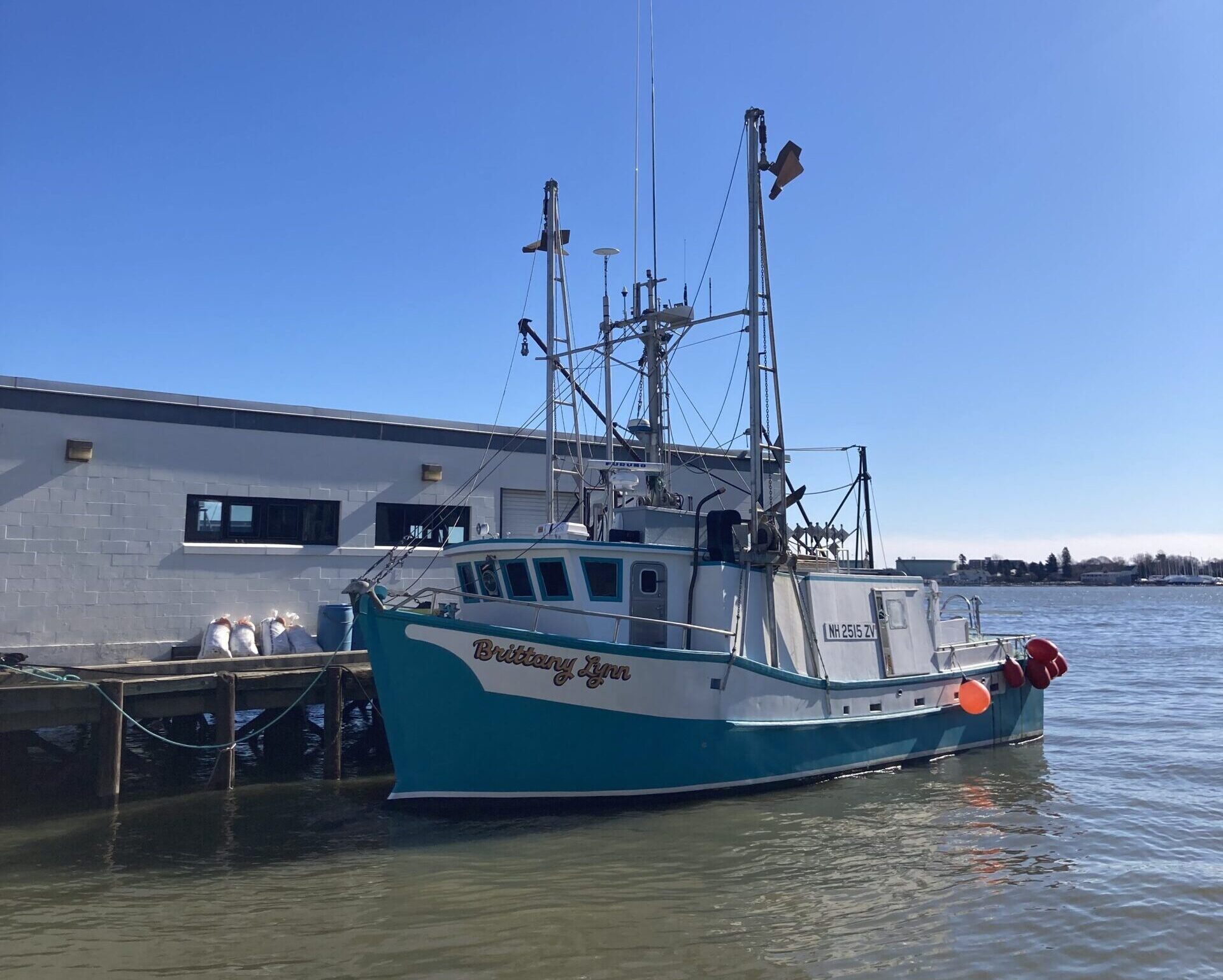 Geordie King, owner of the Brittany Lynn, has been fishing in the Gulf of Maine for 40 years. Credit: Kea Krause
Geordie King, owner of the Brittany Lynn, has been fishing in the Gulf of Maine for 40 years. Credit: Kea Krause
It wasn’t the fishing itself that was the problem. In fact, many boats were able to safely resume operations within the first year of the pandemic — the coastal breeze supplied adequate air circulation; the open ocean, with no land in sight, provided ample social distancing. But as Susan Olcott, the director of operations of the nonprofit Maine Coast Fishermen’s Association (MCFA), lays out, just about every other aspect of the industry was in crisis. Fishermen “didn’t have a market for their catch. Restaurants were closed and overseas markets were not happening,” Olcott explains. “It was not profitable for people to keep fishing.”
When the pandemic struck, MCFA had already been supporting Maine’s fishermen and working waterfronts for 15 years. And as Olcott, along with Ben Martens, MCFA’s executive director, witnessed the pandemic’s havoc on the community, the nonprofit launched a program called Fishermen Feeding Mainers (FFM) to help out people like King as they navigated the unfolding disaster. Using federal Covid relief funding, FFM purchased fish at the Portland Fish Exchange from groundfish captains, which guaranteed competitive prices. By investing in their fish, FFM enabled fishermen to return to work, confident that they would receive fair pay for their catch. In turn, FFM would make good use of the fish: by donating it to local food banks and the food programs of public school districts.
Credit: Kea Krause
Fishermen like King and his crew on the Brittany Lynn saw their entire industry screech to a halt when the pandemic began.
In the four years since its launch, FFM has overseen the distribution of over 850,000 pounds of fish to 280 schools, food banks and community groups, including school districts as far north as Fort Kent on the Canadian border, where fresh fish is near-impossible to source. The program has been such an important source of healthy protein to the schools in Fort Kent that Melanie Lagasse, Unified Valley food service director, will make the five-and-a-half-hour drive to Portland to pick up the FFM fish herself. “The only thing it costs me is my time and fuel,” Lagasse says. And fishermen and fishworkers, including King and his crew on the Brittany Lynn, continue to benefit from the program, which King says buys species like pollock, hake and grey sole — less popular groundfish species — for a more than decent price.
Quite literally, fishermen are feeding Mainers with the help of MCFA. “We broke a million meals after two and a half years,” reports Olcott. Today, that number has risen to 1.25 million meals donated to the food insecure.
Crushed by negative news?
Sign up for the Reasons to be Cheerful newsletter.
[contact-form-7]
Though the goal was to help Maine’s fishermen, in doing so, the folks at MCFA entered into a broader discussion about fish and food insecurity. “Seafood, for so long, has just been outside of local food conversations,” Martens explains. Paraphrasing the sustainable seafood expert Barton Seaver, Martens elaborates on the widely held belief that “food comes from farmers and seafood comes from the ocean.” This idea “really reflects the mindset of most people when you’re thinking about our food system and what you’re eating,” Martens says. “One of our goals is to put the fishermen back into the food system.”
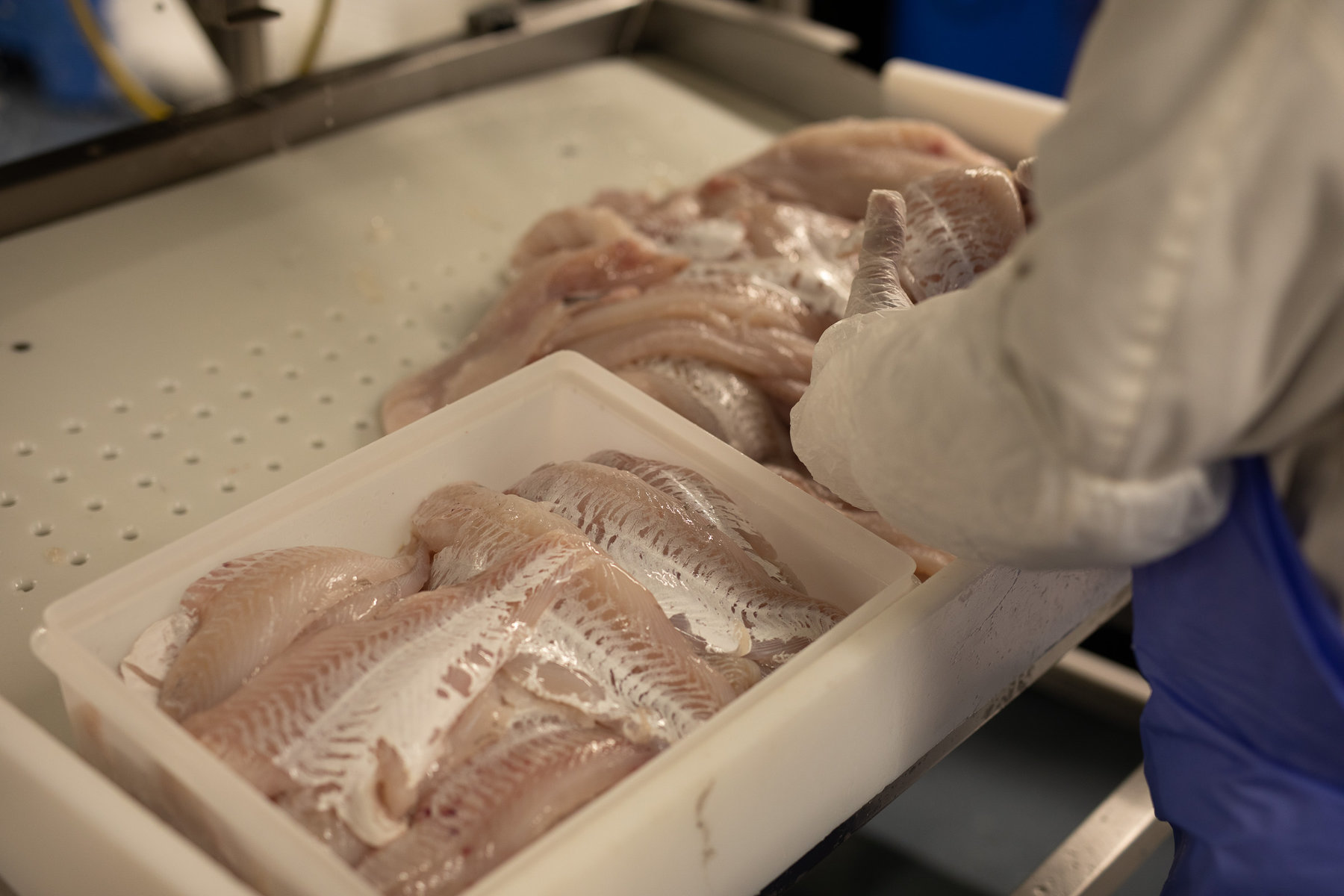 Haddock on its way to be donated to a food pantry. Credit: Scott Gable
Haddock on its way to be donated to a food pantry. Credit: Scott Gable
Part of that effort is confronting ideas we hold about eating fish, one of which is scarcity. “We tell the story about the decline of the groundfish fishery in Maine, and in New England, and a lot of that is attached to cod,” Martens says. While cod was indeed overfished in the 1990s and isn’t expected to recover to sustainable levels until 2030, there is growing evidence in the Gulf that other groundfish populations, like monkfish, pollock and grey sole, are stable. “One of the neat things about Maine fisheries that we can say with good conscience as an organization is that if it’s from Maine, it’s sustainable,” Olcott says. The domestic seafood industry is already highly regulated, but in the Gulf of Maine, there are additional factors that add to sustainability, particularly in the groundfish fleet: Businesses are independently owned and operated, which means a lot of fishermen end up in inadvertent roles as stewards of the fishery. They’re cognizant of the value of harvesting in sustainable ways, and many participate in electric monitoring and gear modification programs.
Amid this ongoing sustainability conversation, one of the bigger challenges FFM faces has also proven to be one of the program’s more replicable features: the purchase and supply of underutilized species. Identifying and developing markets for lesser-known types of fish is not only sustainable but positions fisheries everywhere to weather some of the more severe economic consequences of climate change. But selling people on trying unfamiliar fish comes with some hurdles. Most people are acquainted with cod, less so with pollock, hake and grey sole, even though these fish can all be substituted for most recipes calling for a flavorful, flaky fish.
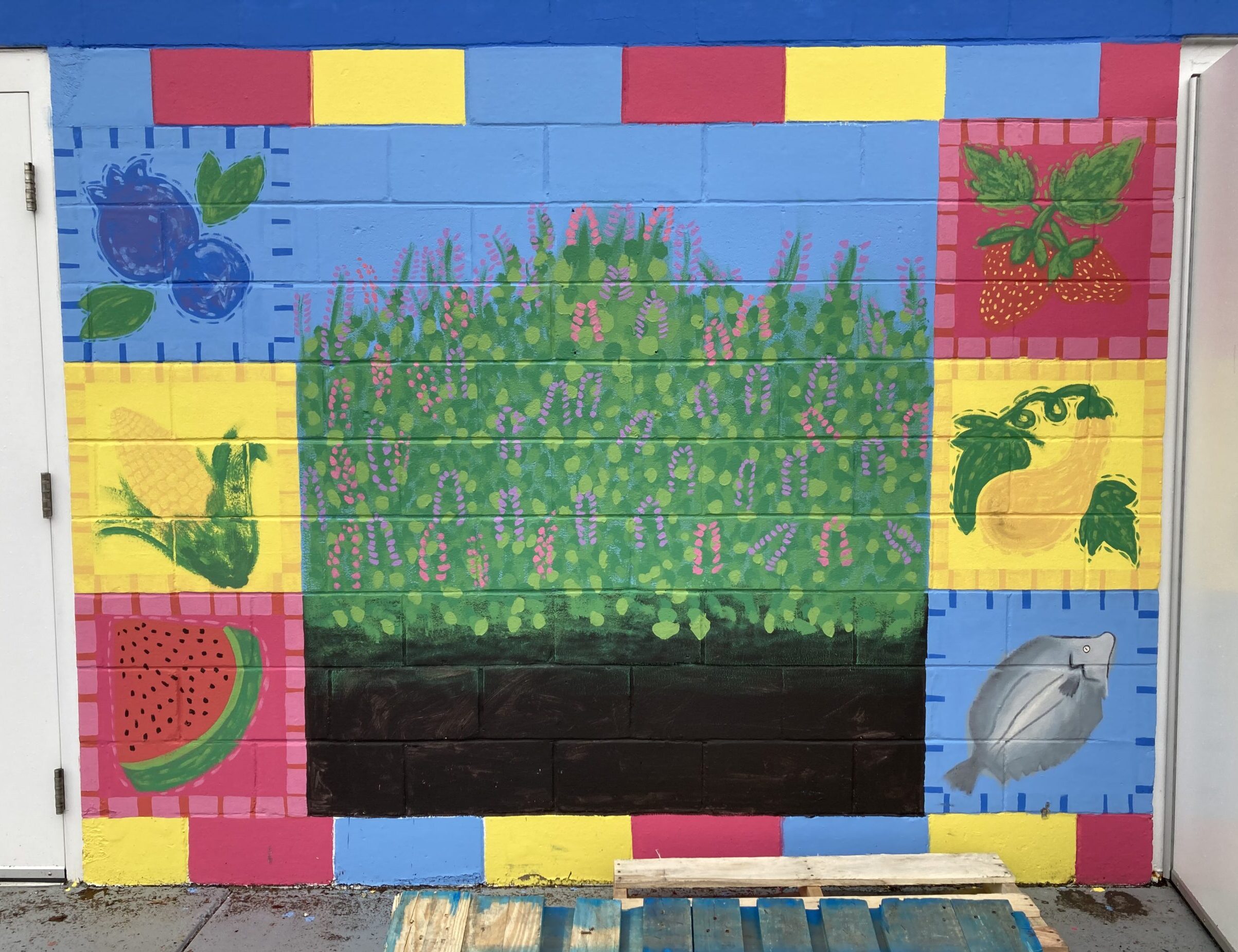 A mural at MaineHealth Food Pantry highlighting local and culturally important foods, including grey sole. Credit: Kea Krause
A mural at MaineHealth Food Pantry highlighting local and culturally important foods, including grey sole. Credit: Kea Krause
Expanding what can be considered culinary, which FFM tries to do with various types of outreach including developing and distributing their own value-added monkfish stew to regional grocers, is a type of messaging that could be adapted by other fisheries nationwide. “We are in a really interesting position where we can slowly start to rebuild those markets with fishermen landing more consistently,” says Olcott. And while perhaps it is a little harder to make people more adventurous about what species they’re eating, how they’re eating it, FFM is finding, is very consistent.
Though there is less of a market based on species, there is one for whole, intact fish. With their bones and skin, along with their meat, whole fish provide more nutrition and more flavor when cooked, and they can be used in a variety of preparations, as opposed to fish that have been processed down into filets and other cuts. At the MaineHealth Food Pantry at Maine Medical Center, a shopping-model food bank where visitors can browse shelves and coolers for food, groundfish from FFM has become a sustaining protein. “Because we’re a hospital-based food pantry, we have certain standards on the healthy food that we’re offering,” Rachel Freedman, the food pantry’s program manager, tells me. “And our focus along those lines is really on culturally important food.” Species of fish that turn flaky and white when cooked swim the oceans worldwide, which makes the groundfish donated by FFM especially important at the Food Pantry: They can be used to replicate just about any dish that calls for white fish, and they are also halal.
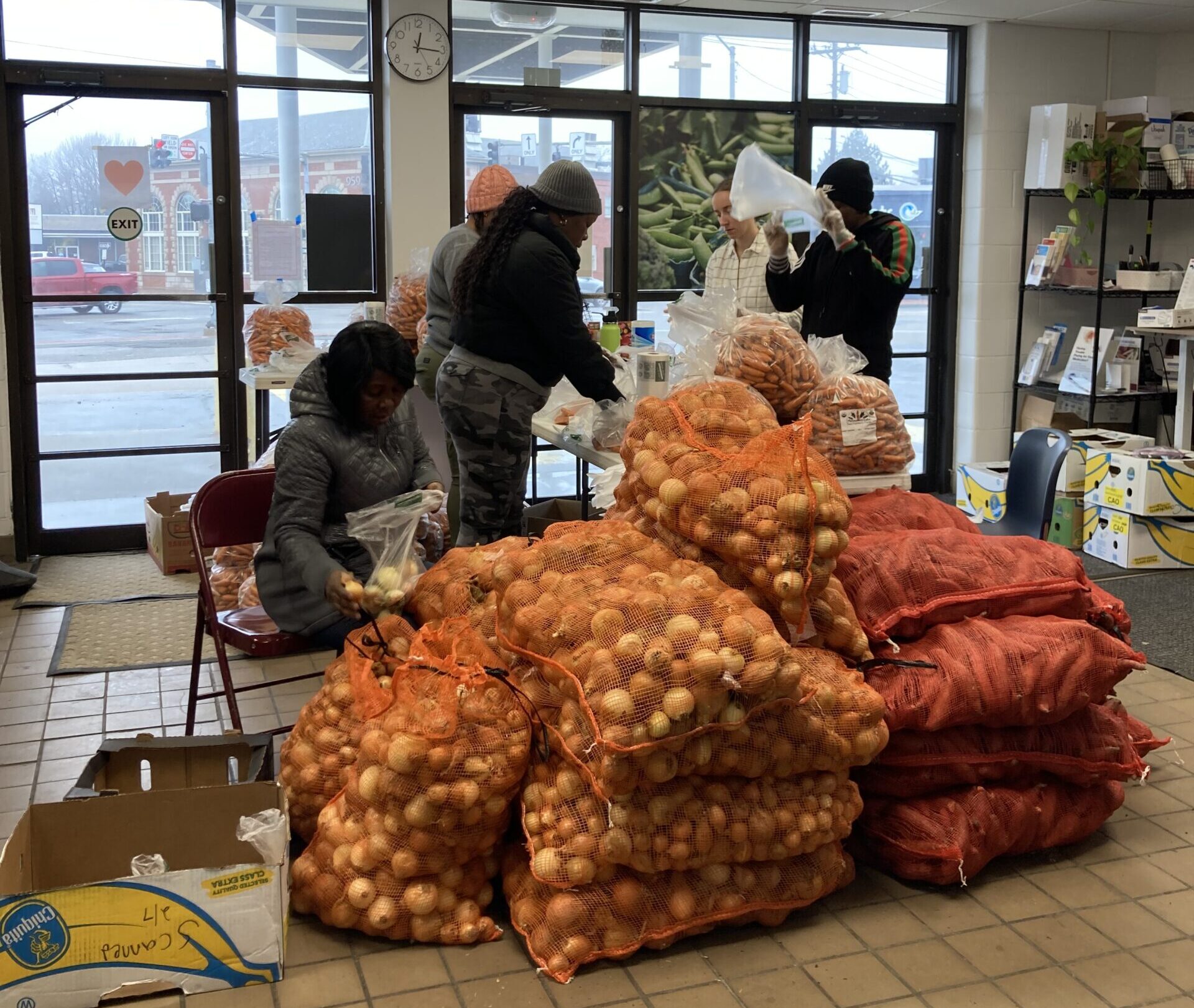 Volunteers at the MaineHealth Food Pantry at Maine Medical Center unload deliveries. Credit: Kea Krause
Volunteers at the MaineHealth Food Pantry at Maine Medical Center unload deliveries. Credit: Kea Krause
Located in Portland’s old Greyhound bus station, the Pantry distributes between 17,000 and 19,000 pounds of food a week to an average of 550 community members and their families. Many of the Pantry’s customers are new to Maine, and the United States more generally, with over 80 percent of visitors speaking French, Portuguese or Spanish as their primary language. With such a diverse clientele, the Pantry has “cultural brokers,” community members that help visitors navigate the space and the products that are available.
Though many of the Pantry’s products are novel to its community members, whole fish spans cultures and languages, and it has become one the Pantry’s most in demand items. “We have folks that are shopping who are from Southeast Asia, that’s what they want. We have folks who are shopping who are from Central Africa, that’s what they want,” says Freedman. “Across cultures, the whole fish is definitely the hottest ticket item.”
At the Pantry, visitors can find a variety of pamphlets and cookbooks by immigrant women living in Maine that offer local substitutions for recipes of their home countries where fish like tilapia is more common. “Some people come in and they’re like, ‘I just got here last week,’” Freedman says. “And some people are a little bit more established. But everyone’s kind of working on, ‘I’m used to this thing. What do we have here in Maine that I can still use in cooking that feels familiar and comfortable and important?’”
Credit: Kea Krause
The MaineHealth Food Pantry distributes between 17,000 and 19,000 pounds of food a week to an average of 550 community members and their families.
On a slick and windy day, the Pantry was in full swing, with volunteers dashing out to trucks and vans in the parking lot to unload the week’s donated goods, including fish from FFM. In all the activity, Nicole, a Congolese cultural broker, showed me pictures of a fish stew she cooked with some of the FFM fish. In addition to her cultural broker role, Nicole prepares culturally and traditionally important food for newly arrived families who are living in temporary housing — usually at a hotel — and do not have access to kitchens to cook themselves. The dish she showed me radiated warmth — it appeared to be bubbling away on a stove — its ingredients, like the fish, perhaps novel but nonetheless nourishing.
“As Maine becomes more diverse, it’s a neat opportunity for Maine seafood, kind of in both directions,” Olcott reflects on the program benefiting both the fishermen and underserved communities.
“It’s just a win-win,” says Vincent Balzano, a third-generation fisherman, who also is a part of the FFM program. “The program establishes a floor for official prices and also allows us to give back to the public.” Balzano still recalls some of the feedback he received when he first got involved with the FFM program and his catch was distributed among food banks. “About a week later, we received a heartfelt thank you from a woman — an elderly woman — that hadn’t eaten haddock in years because she couldn’t afford it,” he says. “I got a better return than I had been getting, the processor that processed the fish was able to keep their cutting room operating and keep their employees paid. And the end result was a woman was able to have a treat that she hadn’t had in years. For me, that really struck a chord.”
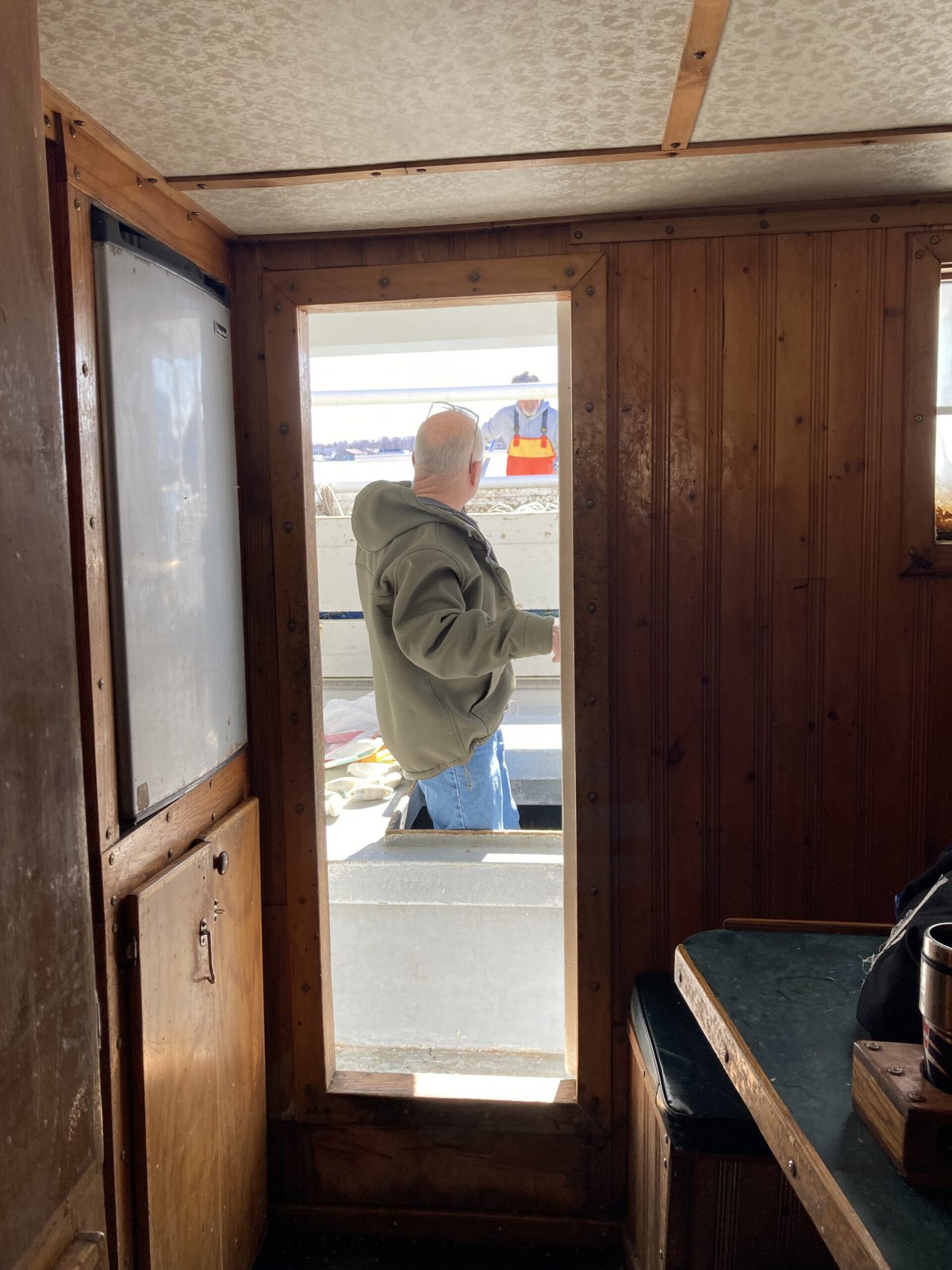 Geordie King on the Brittany Lynn. Credit: Kea Krause
Geordie King on the Brittany Lynn. Credit: Kea Krause
Back on the Brittany Lynn, King used the same phrase, win-win. As he puts it, the FFM program “takes the lows out of the lows” but also makes people feel good as fishermen. And he gets to keep doing what he loves, which is fishing. King missed it during the pandemic and misses it when he hasn’t been out in a while. “When you lose sight of land, it’s just a different world,” he says. “Not everything about fishing is rosy, but I do love the natural environment. Most fishermen will tell you that’s a big part of why they love it. We get to see whales, birds, porpoises. The beautiful blue seas and the stars. We see it all.”
And who wouldn’t want to experience a different world, one in which the role of uncertainty is diminished? For Martens, that added stability is what FFM’s work is all about. “For these people that live in some of the most disruptive times in history for their businesses — we’ve got climate change, we’ve got marketplaces that are all over the place, we’ve got regulations that are changing, we’ve got gentrification up or down our coast,” he notes. “These communities are changing faster than they probably ever have. All of these things are contributing to uncertainty. But there are places that we can bring a little bit of certainty back, a little stability back. And this program is one piece of that equation.”
The post How Unfamiliar Fish Are Helping Mainers Fight Food Insecurity appeared first on Reasons to be Cheerful.
Testing the Waters in Gotham
The three forms of water distribution form a fluid archive of community formation, civic pride, and the many different possible ways New Yorkers can choose the water they drink....
South Africa calls on ICJ to take ‘additional emergency measures’ against Israel for Gaza
World court asked to rule immediately, without the delay of a hearing
South Africa has called on the International Court of Justice (ICJ) to take extra ‘urgent’ measures against Israel and its genocide in Gaza – including ordering an immediate halt to military action and to any actions by Israel that may prejudice the right of the people of Gaza not to be subjected to genocide.
The request also asks the ICJ to order Israel to act immediately to ensure the provision of humanitarian assistance and the restoration of essential services by ceasing all military operations and ending its blockade of the Gaza Strip, to ensure Palestinians can access food and water.
Because of the urgency of the situation – with hundreds more civilians slaughtered daily and hunger and disease now becoming the biggest killers in Gaza – South Africa has asked the court to issue an emergency ruling without a hearing:
SKWAWKBOX needs your help. The site is provided free of charge but depends on the support of its readers to be viable. If you’d like to help it keep revealing the news as it is and not what the Establishment wants you to hear – and can afford to without hardship – please click here to arrange a one-off or modest monthly donation via PayPal or here to set up a monthly donation via GoCardless (SKWAWKBOX will contact you to confirm the GoCardless amount). Thanks for your solidarity so SKWAWKBOX can keep doing its job.
If you wish to republish this post for non-commercial use, you are welcome to do so – see here for more.
Taking Water for Granted
Water use has always been an indicator of social relations. In western societies, most treat drinking water as a simultaneously infinite and hyper-individualized resource. But plastic pollution and the climate emergency are forcing us to question our consumption habits....
Exclusive: Graham’s Unite ‘spending €150,000 A DAY’ on lawyers in Ogle abuse case
1.35 million euros flushed on legal team over 9-day case according to union sources – and that’s just the tribunal, with the defamation suit to follow
Sources within the union say that Sharon Graham’s Unite is spending spending €150,000 a day just on the fees of its legal team to defend the discrimination tribunal case brought against Unite by leading Irish trade unionist Brendan Ogle – a staggering €1,350,000 across the planned nine days of the Workplace Relations Commission hearing in Dublin, not including court and other costs.
Ogle brought his complaint against his union employers after he was sidelined, following his successful battle against neck cancer, to an office fifty miles away from his Dublin home, despite a promise from Ms Graham’s predecessor Len McCluskey that his job would be kept open for him pending the outcome of his treatment. Cancer qualifies as a protected characteristic under equality legislation in both Ireland and the UK.
Ogle told the tribunal last week that another senior Unite employee in Ireland called him to a meeting after his return to work and told Ogle that:
he’d been told by Sharon Graham to draw up a strategic plan for the Republic of Ireland and I was not to be in it.
The case could, presumably, easily have been settled for no more, and probably considerably less, than €1.35m – but Unite has deployed no fewer than seven lawyers to defend it:
1 Senior barrister
1 Junior barrister
1 Legal Director
3 Solicitors
2 Legal Execs
Ogle, in contrast, has a junior barrister and a solicitor.
As well as the employment tribunal case, Brendan Ogle is also suing Graham, her ally Tony Woodhouse and Unite for defamation over comments made about him to union members at different events. Unite is employing the same legal firm – one of the world’s most expensive and profitable – in the defamation case, probably at similar or even greater cost.
One union source told Skwawkbox:
That’s the entire annual subs at full rate of 5,769 members. Sharon hasn’t published an Annual Report since she became general secretary. That’s unheard of – and for someone who has spent so much time accusing others of malpractice, it’s extraordinary.
The union’s ‘disgusting’ abuse toward Ogle on his return from cancer treatment triggered widespread outrage among grassroots members, politicians and community groups – anger so serious that an entire sector branch threatened to disaffiliate entirely from Unite, the well-known ‘Right2Water’ campaign said it will no longer work with Unite, Unite’s Community section in Ireland condemned the ‘injustice inflicted’ on him and members picketed general secretary Sharon Graham’s long-delayed visit to Dublin last month.
Sharon Graham’s tenure at Unite has also been marked by a string of other serious allegations, which neither she nor the union has ever denied – of abuse, cover-up and failure to protect women:
- that she attempted to have evidence destroyed in bullying and misogyny complaints about her husband, whom she now employs in her office despite a final warning from the union for his behaviour
- after her supporters failed in their bid to take control of the Unite executive despite ‘dark money’ spending on advertising, ineligible and racist members being allowed to stand and the alleged use of paid organisers in and following the exec election campaign, her faction has resorted to Starmerite tactics to try to discredit the executive members’ election of a new left-wing union chair and both vice-chairs, as well as the vital Finance and General Purpose Committee
In addition, she has been exposed behind the union’s decision to ban showings in Unite’s buildings of a film exposing racism, smears, rigging and abuse by the Labour right and has appeared to grow increasingly cosy with red-Tory Labour ‘leader’ Keir Starmer, despite Starmer’s lies, his contempt for democracy, his u-turns on promises to Unite members and his regime’s repeated blocking of Unite-backed parliamentary candidates.
Unite did not respond to a request for comment.
Update: more than two hours after the response deadline – and an hour after publication of this article – Unite responded with a generic denial:
“This story – like the other stories that The Skwawkbox has published as part of its smear campaign – is untrue.”
The statement, which did not specify whether the amount spent is higher or lower or by how much, went on to smear this site, implying the scrutiny of Ms Graham’s spending and activity was linked to a Birmingham hotel and conference centre project and Ms Graham’s ‘findings’ about it.
Ms Graham was part of the group of senior Unite figures that approved the Birmingham project. Her close ally Tony Seaman was the ‘project-specific convenor’ on the project, a role that appears to have been created especially to accommodate him. Unite, with Graham as general secretary, subsequently whitewashed racism findings against Mr Seaman, despite agreeing that he had made racist comments.
SKWAWKBOX needs your help. The site is provided free of charge but depends on the support of its readers to be viable. If you’d like to help it keep revealing the news as it is and not what the Establishment wants you to hear – and can afford to without hardship – please click here to arrange a one-off or modest monthly donation via PayPal or here to set up a monthly donation via GoCardless (SKWAWKBOX will contact you to confirm the GoCardless amount). Thanks for your solidarity so SKWAWKBOX can keep doing its job.
If you wish to republish this post for non-commercial use, you are welcome to do so – see here for more.
How Farmers Are Preparing for a Saltier Future
When Arjan Berkhuysen and his fellow volunteers on the Dutch island of Terschelling looked for a spot to start a garden, they sought the least fertile location they could find. The plot they landed on is just over a dike from the Wadden Sea along the Netherlands’ northern coast. The water in the irrigation ditches is often brackish. For most growers, salinity is an affliction; salt in soil or water can diminish plant health and reduce crop yield. But for this group of gardeners, the spot was ideal.
De Zilte Smaak — “The Salty Taste” — specializes in edible plants that grow in saline conditions, like samphire, tiny spears that resemble asparagus, and tender-leafed sea aster. The salt-loving delicacies grown on this plot end up on plates in restaurants across this island, a popular summer destination. The project is one of a number of initiatives in the Netherlands exploring the possibilities of farming in salty conditions, ranging from edible plants in small-scale gardens like this, to identification of salt-tolerant varietals of conventional crops like potatoes and beets.
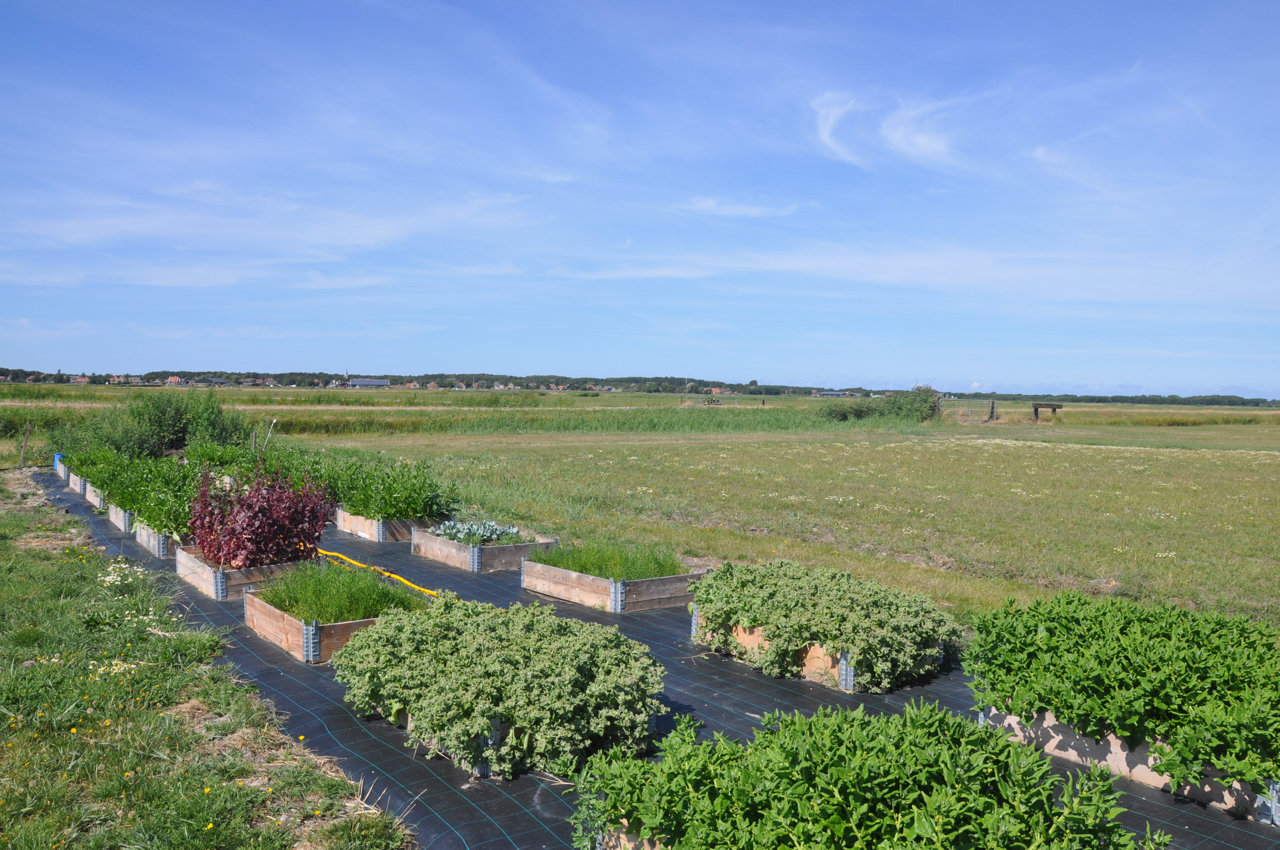 Most of the vegetables De Zilte Smaak grows are distributed to local restaurants. Courtesy of Stichting De Zilte Smaak
Most of the vegetables De Zilte Smaak grows are distributed to local restaurants. Courtesy of Stichting De Zilte Smaak
In the Netherlands and worldwide, more and more farmers are facing challenges with food production as climate change makes soils and water saltier. Globally, an estimated 20 percent of cultivated land is affected by salinity. In the Netherlands, where a quarter of land is below sea level, some regions are seeing impacts already, and salinity is expected to become a more prominent hurdle for agriculture in the decades ahead. But recent developments are proving it’s possible to adapt farming techniques and crops to saline conditions.
“As humans, we tend to always adapt the environment to us,” says Berkhuysen, a member of De Zilte Smaak’s board. “Here, [we] try to adapt ourselves to the environment.”
For cooking, salt can make food tastier. But for farming, it’s generally bad news. When salt becomes concentrated in soil or water, it can damage plants, reduce the yield of crops, and even make farmland useless.
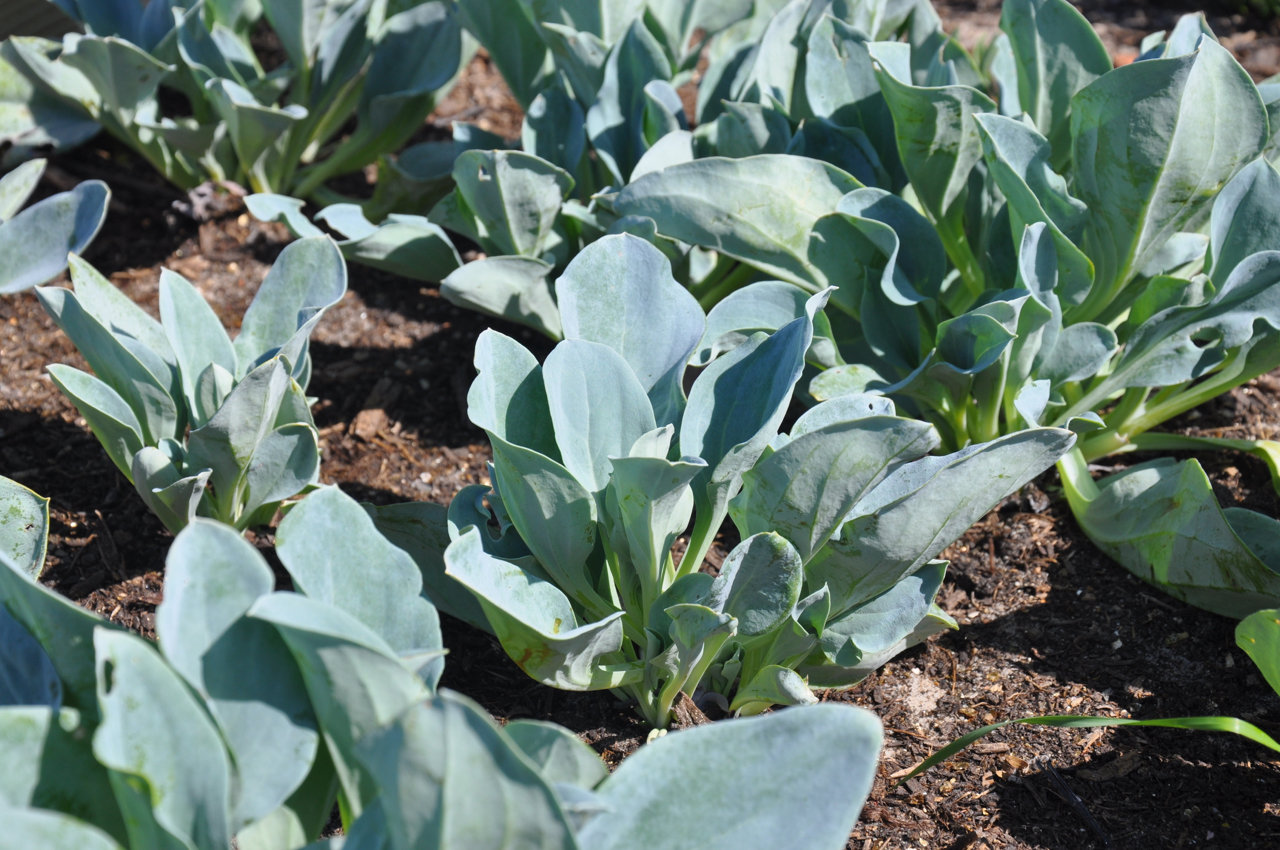 Oesterblad, or oyster leaf, is among the salt-tolerant plants De Zilte Smaak grows. Courtesy of Stichting De Zilte Smaak
Oesterblad, or oyster leaf, is among the salt-tolerant plants De Zilte Smaak grows. Courtesy of Stichting De Zilte Smaak
“It can be a big problem because for a lot of cash crops salinity is not good,” says Kate Negacz, an assistant professor with Vrije Universiteit Amsterdam’s Institute for Environmental Studies. She heads the Saline Agriculture for Adaptation (SALAD) project, which is researching saline agriculture in Europe and North Africa. “They will perform worse, which can then lead to food security challenges.”
Salinization is not a new problem. Evidence suggests salinity hindered ancient societies from Mesopotamia to Peru. But phenomena associated with climate change and other human activities are driving salinity in a number of ways. Warmer temperatures, for instance, lead to higher rates of evapotranspiration; as water leaves the soil through evaporation and is taken up by plants, salt is left behind. During periods of drought, when there’s little rain, salty seawater can seep inland via groundwater and the mouths of rivers. Even in areas far from the coast, salt can concentrate as groundwater depletes. Rising sea levels are also leading to more flooding involving saline water, leaving impacts on the land.
In a rice-growing region in Vietnam, where salinity once reached 30 to 50 kilometers from the coast, it now is seeping in more than 100 kilometers. Inland areas are affected too: in Australia, severe salinity impacts more than one million hectares of formerly productive farmland. Mid-Atlantic farmers in the United States are struggling with salt patches. Coastal erosion and sea-level rise in Egypt are deteriorating the quality of cultivated land.
The post How Farmers Are Preparing for a Saltier Future appeared first on Reasons to be Cheerful.
Ski Resorts Are Turning Wastewater into Snow
This story was originally published by Montana Free Press at montanafreepress.org.
The Yellowstone Club, the elite resort near Big Sky that in the past has counted Bill Gates, Justin Timberlake and Jessica Biel as members, has become the first ski area in Montana to turn wastewater into snow. And while skiing on what was once sewage might seem odd at first blush, resort officials and local conservation groups said it’s both safe and beneficial to the environment, especially during dry winters like this one, which has left some ski areas in the state shuttered.
In fact, Richard Chandler, vice president of environmental operations for the Yellowstone Club, said recently that the new program to turn wastewater into snow is helping the resort open more runs than it otherwise might be able to this winter.
“Without [snowmaking], we’d be skiing on a lot less terrain,” Chandler said.
The new effort to use recycled water to increase the base layer of snow on Eglise Mountain follows a decade of collaboration between the resort and local environmental groups, plus a multi-year review by state regulators. It isn’t the first time the Yellowstone Club has found a new use for wastewater: For several years, it has been using recycled water to irrigate its golf course.
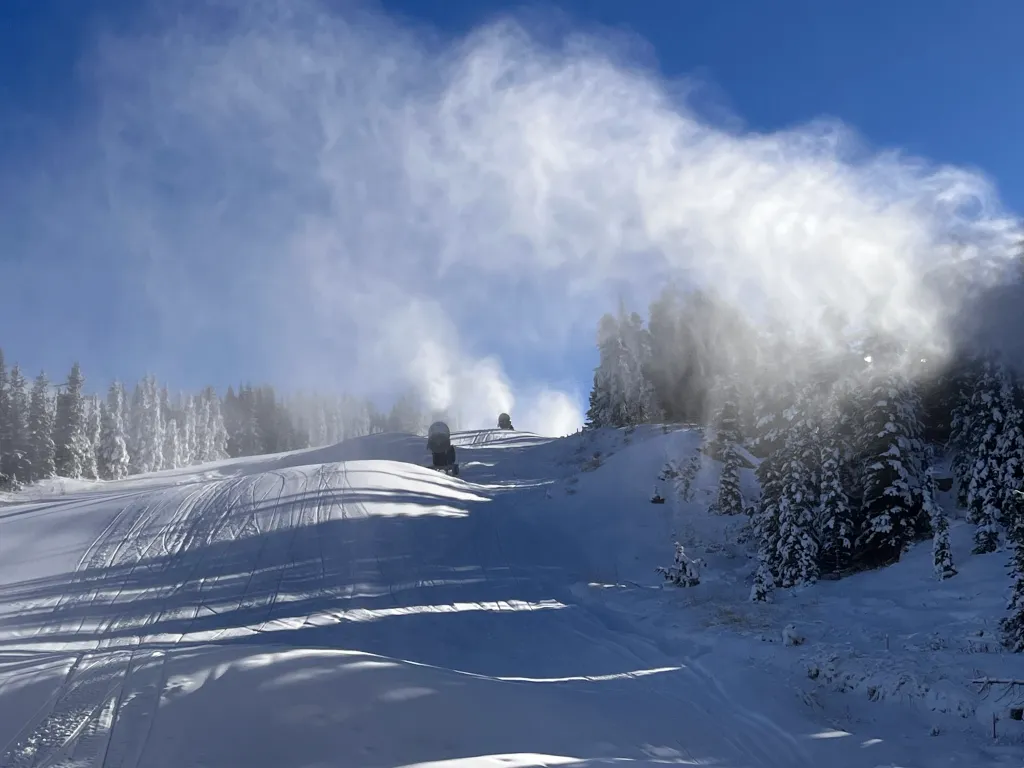 Officials at the Yellowstone Club say that using wastewater to make snow has allowed the resort to open more terrain to skiers this winter. Courtesy of the Yellowstone Club
Officials at the Yellowstone Club say that using wastewater to make snow has allowed the resort to open more terrain to skiers this winter. Courtesy of the Yellowstone Club
In 2011, the Gallatin River Task Force, Yellowstone Club and DEQ studied whether wastewater could be used to make artificial snow to ski on. The idea was that as climate change made the region’s snowpack more unpredictable, they could serve skiers and the watershed by making snow from treated water that is traditionally just put into rivers and other bodies of water. That winter they successfully turned a half-million gallons of wastewater into two acres of snow about 18 inches deep.
According to the Yellowstone Club, 12 ski areas in eight states, plus some in Canada, Switzerland and Australia, have used wastewater to make snow in the past. However, the practice hasn’t been without controversy. About a decade ago, a ski area near Flagstaff, Arizona, was sued by a local tribe over environmental concerns about turning wastewater into snow. The Hopi Tribe also alleged that the practice would desecrate a mountain it considered sacred. The tribe eventually lost in court, but during the dispute some environmental groups, including the Center for Biological Diversity, raised concerns about the impact the recycled snow might have on aquatic life in the area.
But Chandler said that using recycled water to make snow treats the wastewater even more than it normally would be before being released into a river. By shooting it through the snowmaking equipment (it’s essentially misted onto the slopes as snow) the wastewater is treated again. Then, as it melts in the spring and enters the ground, it’s filtered a third time. Chandler also said that the compacted snow on the slopes will last longer into spring and summer, adding water to the aquifer at a critical time and helping streamflows later in the season. Because of that, groups like the Gallatin River Task Force, Trout Unlimited, American Rivers, Great Yellowstone Coalition and the Association of Gallatin Agricultural Irrigators all came out in favor of the project. Chandler estimates that the man-made snow will increase summer runoff in area creeks by about 19 days.
Crushed by negative news?
Sign up for the Reasons to be Cheerful newsletter.
[contact-form-7]
“The benefits of this project are actually an enhancement to the watershed function,” said Pat Byorth, Montana water director for Trout Unlimited, in a press release. “It’s an enhancement to water supply, to water quality in the basin. So everybody from skiers to anglers will benefit from this, and downstream agriculture benefits at a time where water supply is uncertain.”
In 2020, the Yellowstone Club applied for a permit from DEQ to expand that 2011 pilot program into a permanent snowmaking operation on Eglise Mountain. The following year, the state issued a permit allowing the Yellowstone Club to turn 25 million gallons of wastewater into snow annually. Two years and $12 million later, the new system began making snow last November. Under the current plan, 80 percent of the recycled water is coming from the community of Big Sky and 20 percent is coming from the Yellowstone Club. As part of its permit, the Yellowstone Club is required to erect signage warning visitors not to consume the snow.
As winters get drier in the American West, Chandler said that turning wastewater into snow could be the key for ski areas across the region in the future. He said he hopes the club can set an example.
“We hope that we can show other ski areas in the state what is possible,” he said. “We might be the first, but I hope we aren’t the last.”
The post Ski Resorts Are Turning Wastewater into Snow appeared first on Reasons to be Cheerful.


